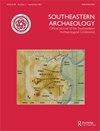Spanish Florida’s eighteenth-century presidios and the tale of their ceramics
Q1 Social Sciences
引用次数: 2
Abstract
ABSTRACT At the turn of the eighteenth century, two military presidios – West Florida and San Agustín – anchored the shrinking and besieged colony of Spanish Florida. Unlike San Agustín that stayed in one place, the West Florida presidio was relocated three times, creating four geographically separate and chronologically sequential sites of the same community and enabling fine-grained temporal analyses. Here, I analyze ceramic trends that reveal three Mexican majolica types, Olive Jar, and the tempering agents of Native American ceramics that are temporally sensitive. However, these ceramic trends are a cautionary tale as they may be specific only to the West Florida Hispanic and Native American settlements in this region. When comparing the ceramics from West Florida and San Agustín, the main difference is a much higher proportion of Native American ceramics in San Agustín, which I attribute to the presence of many Indian and local mestizo women in their households. This demographic was not as substantial in West Florida. The differences in the two eighteenth-century Spanish Florida presidios reflects flexibility at the local level in implementing a highly regulated Spanish imperial system that enabled their colonial empire to include innumerable indigenous cultures in a variety of historic circumstances.西班牙佛罗里达的18世纪总统和他们的陶瓷故事
在十八世纪之交,两个军事总统——西佛罗里达和圣Agustín——巩固了西班牙佛罗里达这个萎缩和被围困的殖民地。与停留在一个地方的San Agustín不同,西佛罗里达的presidio被搬迁了三次,创建了四个地理上独立的、按时间顺序排列的同一社区的地点,并进行了细粒度的时间分析。在这里,我分析了陶瓷的趋势,揭示了三种墨西哥马略利卡陶瓷类型,橄榄罐,以及美洲原住民陶瓷的回火剂,它们对时间敏感。然而,这些陶瓷趋势是一个警示故事,因为它们可能只适用于西佛罗里达的西班牙裔和该地区的美洲原住民定居点。当比较来自西佛罗里达和圣Agustín的陶瓷时,主要的区别是圣Agustín的美洲原住民陶瓷比例要高得多,我认为这是由于家庭中有许多印第安人和当地的混血人妇女。这一人口统计在西佛罗里达没有那么多。两个18世纪西班牙佛罗里达总统的差异反映了地方层面在实施高度规范的西班牙帝国体系方面的灵活性,这使得他们的殖民帝国能够在各种历史环境下包括无数的土著文化。
本文章由计算机程序翻译,如有差异,请以英文原文为准。
求助全文
约1分钟内获得全文
求助全文
来源期刊

Southeastern Archaeology
Social Sciences-Archeology
CiteScore
1.40
自引率
0.00%
发文量
25
期刊介绍:
Southeastern Archaeology is a refereed journal that publishes works concerning the archaeology and history of southeastern North America and neighboring regions. It covers all time periods, from Paleoindian to recent history and defines the southeast broadly; this could be anything from Florida (south) to Wisconsin (North) and from Oklahoma (west) to Virginia (east). Reports or articles that cover neighboring regions such as the Northeast, Plains, or Caribbean would be considered if they had sufficient relevance.
 求助内容:
求助内容: 应助结果提醒方式:
应助结果提醒方式:


